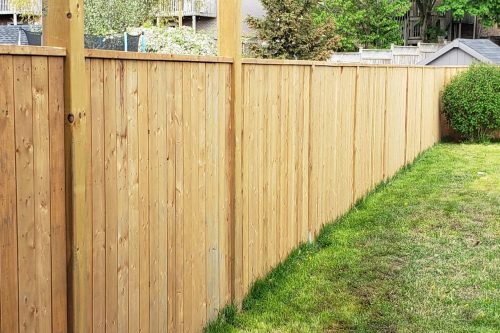Cedar FENCE MAPLE RIDGE is a maple species that can be found in eastern North America. This maple has an interesting history, as it was once commonly used to make fence posts and other wood products. In recent years, Cedar FENCE MAPLE RIDGE populations have been declining due to a number of factors, including the spread of pests and diseases, loss of habitat, and degradation of forests. Recognizing Cedar FENCE MAPLE RIDGE can help you conserve this species and protect its habitat in the future. So if you’re looking for a unique maple tree to add to your garden or landscape, be sure to check out the Cedar FENCE MAPLE RIDGE!
What is Cedar FENCE MAPLE RIDGE
Cedar FENCE MAPLE RIDGE is a composite wood product that combines the beauty of cedar and the hardiness of maple. It’s ideal for use in both residential and commercial applications, such as decking, fences, gates, and other structures. Cedar fence maple ridge is constructed using select-grade lumber from American forests that have been kiln-dried to maintain their natural structural integrity. This produces a durable product that can handle weather conditions well while delivering an attractive appearance.
Cedar FENCE MAPLE RIDGE is a branded consumer goods company that produces and sells natural wood products, including cedar fences, decks, railings, and more. The company has a loyal following because of its dedication to eco-friendly practices and sustainable forestry. Products are made from select hardwoods that are sourced from sustainably managed forests certified by the Forest Stewardship Council (FSC). Cedar FENCE MAPLE RIDGE also manufactures all of its products in the United States using energy-efficient machines.

Identification tips
There are Identification tips:
-Look for cedar fence maple ridge panels that are finished with a natural finish.
-Look for cedar fence maple ridge panels that have been kiln-dried to maintain their structural integrity.
-Check the product’s licensed lumber certification (to see if it is certified by the Forest Stewardship Council).
-Pay attention to the panels’ dimensions. They should be at least 2 inches thick and should measure 48 inches wide by 96 inches long.
Cedar FENCE MAPLE RIDGE can be easily identified by its distinctive bark. The bark is dark brown and rough, with a ridged texture. The leaves are alternate, lance-shaped, and have serrated margins. The fruit is a small samara that contains two seeds inside of it. Cedar FENCE MAPLE RIDGE grows best in moist soil that’s well drained.
Habitat and distribution
Habitat and distribution are critical factors in the success of any species. Not only do they need a place to live, but they also need to find enough food and water to survive. In order to study how habitat affects distribution, researchers use an experimental design called a controlled experiment.
In this type of study, the researcher establishes certain conditions (e.g., amount and quality of food) in one group of animals, then compares these conditions with another group that has not been exposed to the same conditions. By doing this over multiple generations, researchers can learn more about how specific environmental stimuli affect animal populations over time.
One recent controlled experiment looked at how variation in habitat size affects population density in two montane bird species. The three-wattled bellbirds (Urocissa tristis) and snow bunting (Plectrophenax nivalis). The results showed that while both species thrived under large habitats (>1500 m2), population densities were highest when birds had access to smaller habitats (<600 m2). This suggests that small habitats provide increased opportunities for isolation among individuals, which may be essential for limiting competition for resources or spreading disease organisms amongst populations.
Researchers are continuing to study the impacts of habitat on distribution; their work will help us better understand how human activities such as deforestation impact wildlife across wide geographic ranges.
Cedar FENCE MAPLE RIDGE - conservation considerations
Cedar FENCE MAPLE RIDGE is a unique and endangered ecological treasure located in northwestern Pennsylvania. The fence protects the forest from physical damage, preserves natural wildlife corridors, and enhances recreational opportunities. In order to ensure that Cedar FENCEMAPLE RIDGE continues to be preserved for future generations, it is important to understand its conservation considerations.
The primary goal of managing Cedar FENCEMAPLE RIDGE should be to maintain habitat quality and protect key species while allowing public access for hunting, fishing, hiking, birdwatching, picnicking and other forms of recreation. To do this effectively requires an understanding of the distribution map (structure), population sizes (emergence/abundance), prey preferences (importance) as well as seasonal dynamics (frequency). All data must be collected accurately and regularly in order to make sound decisions that will preserve this special place for years to come.
Other names for Cedar FENCE MAPLE RIDGE
Cedar FENCE MAPLE RIDGE can be a difficult tree to identify, as it can be referred to by a variety of different names. Here are five of them: American Red Maple, Eastern Red Cedar, Swamp White Oak, Northern Red Oak, and Quaking Aspen. It is a maple tree that grows to a height of 30-50 feet and is a part of the maple family. The leaves are broad and rounded, and the bark is reddish brown in color. The fruit is sugarcane-like and contains small seeds that are eaten by birds and other animals.
Conclusion
In this blog, we have covered everything you need to know about Cedar FENCE MAPLE RIDGE. By understanding the characteristics of this species, you can make an informed decision about whether or not to protect it. Additionally, we have provided identification tips and conservation considerations to help you protect this unique species.
In Maple Ridge, British Columbia, Canada, Cedar FENCE MAPLE RIDGE is located in the North Fraser Lowland. It can be found throughout the lowlands and valleys of this area, but it is especially abundant near cedar-swamp habitats. The maple tree grows rapidly and can reach a height of 50 feet or more. It has broad leaves that are rounded at the edges, red-brown bark, and small sugarcane-like seeds. The maple tree flowers in early spring and produces sweet fruit that attract wildlife to its location.


